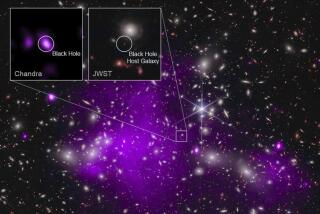X-rays show galactic black hole spinning near speed of light
- Share via
Black holes may have given up some secrets of their growth thanks to the sleuthing of two X-ray space telescopes. The findings have solved a long-standing mystery about a supermassive black hole’s spin, finding that some of them can whirl very close to what the speed of light allows.
NASA’s X-ray telescope NuSTAR teamed up with the European Space Agency’s XMM-Newton space telescope and found that the black hole anchoring nearby galaxy NGC 1365, sitting about 56 million light-years away and containing the mass of 2 million suns, is spinning at 84% of the maximum possible rate, according to a study released Wednesday in the journal Nature.
[For the record, Feb. 28, 10:40 a.m.: An earlier version of this post said NGC 1365 is about 56 million miles away. It is about 56 million light-years away.]
Astrophysicists have long looked for clues about the growth of supermassive black holes, which sit at the heart of virtually all galaxies. Such singularities started off a few hundred million years after the Big Bang as tiny “seeds” with the mass of 20 to 30 suns. How they grew to devour millions and billions of suns’ worth of matter remains an astronomical riddle, but researchers believe it has something to do with their spin rate: A faster-spinning black hole must have had massive amounts of gas and dust dumped into it in one or a few dramatic events, but a slower-spinning black hole probably drew in matter at a more measured pace.
PHOTOS: Awesome images from space
“In this way, the black-hole spin is a ‘fossil remnant’ of its formation processes,” Christopher Reynolds, an astronomy professor at the University of Maryland who was not involved in the study, wrote in an editorial accompanying the Nature paper.
Because scientists can’t see the black hole itself, they look for the spin’s effects on the accretion disc, the surrounding ring of gas and dust. They study X-ray light reflected by the disc’s inside edge to see whether it shows that space-time is being twisted. (The accretion disk can move closer to the black hole’s event horizon if the black hole is spinning, enhancing the “twisting” on the disc’s inside edge and making the effect easier to see.)
But with low-energy X-rays, it’s hard to tell whether this twisting is really due to the black hole’s spin or simply distortion from layers of gas blocking the X-ray light’s path to us.
To solve the mystery, the XMM-Newton telescope -- which studies low-energy X-rays, up to about 10 kiloelectron volts -- teamed up with NuSTAR -- which looks at very high-energy X-rays. NuSTAR, with a range from 3 to 79 kiloelectron volts, would fill in the rough sketch scientists had of this black hole.
Together, the two found that the X-rays reflected from the black hole’s accretion disc matched a pattern that would be seen only if the matter was getting roughed up by the the black hole’s spin.
“If you were standing near the event horizon of this particular black hole, you would have to turn around because your space-time is twisting,” NuSTAR lead scientist Fiona Harrison, a Caltech astrophysicist, said at a news conference. “You would be turning around once every four minutes just to stand still.”
Now that the scientists know that the light they see is indeed telling them about the spin, astrophysicists will be a significant step closer to understanding black holes’ growth and development, said Arvind Parmar, head of the European Space Agency’s division for astrophysics and fundamental physics missions.
“Often in science when you solve one puzzle, you open the door to a deeper, more profound mystery,” Parmar said.
Follow me on Twitter @aminawrite.







